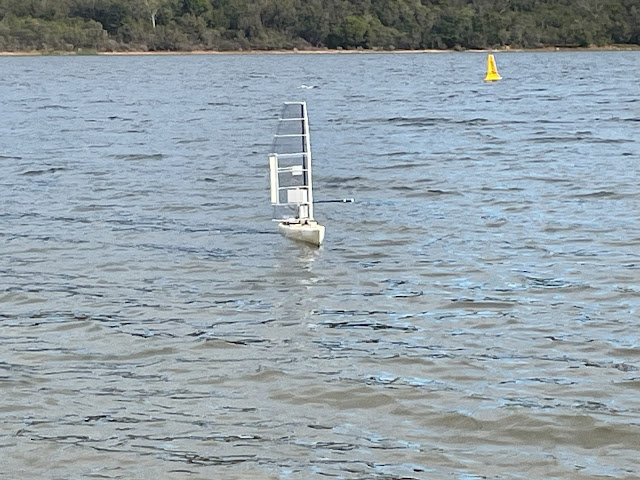New Self Trimming Wing Sail Design - Tailless
A symmetrical foil generally has the Centre of Pressure (CoP) at a position about 25% of the chord from leading edge.
Hence a reliable configuration for a self-trimming wing sail is to place the axis of the wing sail at the 25% point, and then add a separate tail to ensure the CoP is well behind the pivot point.
Influential Sailing Drones
These are images of significant Sailing Drones equipped with self-trimming wing sails that have strongly influenced the design of the Voyager Drones.
 |
| Saildrone Explorer |
 |
| Saildrone Surveyor |
 |
| Maribot |
Voyager Sails
The following images show a series of different Self-Trimming Wing Sails on Voyagers.
 |
| Voyager 3 |
 |
| Voyager 2.0 with first version of wing sail |
 |
| Voyager 2.8 with evolved wing sail with tail |
One problem appeared to repeat on two different voyages.
This was a loss of sailing performance, probably due to the wing sail tail being damaged.
It was determined that the sail assembly might be more robust if the tail is removed from the design.This can be done if the pivot point is moved forward of the 25% neutral point.
It is unclear what optimum point is, perhaps between 14% and 20%.
Tailless Self-Trimming Wing Sail
Voyager 2.9 has been rebuilt with a tailless self-trimming wing sail with a pivot point at 16% of the chord.
 |
| Voyager 2.9 with Tailless Self-Trimming Wingsail |
The Tailless Self-Trimming Wing Sail with an axis at 16% of the chord appears to perform as well as previous sail with tails. It appears to be just as stable, showing no signs of unexpected behaviour.
This sail should be more robust with the elimination of the tail.
A future refinement may be to construct the sail from fibre glass coved foam core for increased strength to resist to damage in breaking waves.
A further design change was the choice of foil. The recent Voyager Wing Sails have all been NACA 0018 (a symmetrical foil with 18% thickness),
The new sail employees an Eppler 169 (E169) foil (~15% thickness). The Eppler foils are intended for use with low Reynold's numbers, typical of those found on small vessels such as Voyager.
 |
| Voyager 2.9 with Tailless Self-Trimming Wingsail on the water |
Saildrone's Hurricane Sail
I later realised that Saildrone had already developed a tailless version of the self-trimming wing sail.
It is designed with a smaller highly robust self-trimming wing sail for deployment during hurricane season.
Measurement taken from photographs suggest that it's pivot point at around 19% or slightly more.
Future Study
Future work will involve preparing a test foil which allows for an adjustable pivot point. The aim is to allow the pivot point to be varied between 15% and 30% to allow for testing in a wind tunnel environment.
The likely aim will be to find the position representing the largest percentage away from the leading edge for the axis, where the sail still exhibits stability and "weather vane" behaviour.

